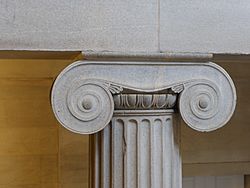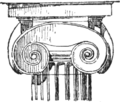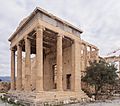Ionic order facts for kids
The Ionic order is one of the three main classical orders (styles) of ancient Greek and Roman architecture. The other two are the Doric order and the Corinthian order (which gave rise to the Composite order). The Ionic capital is notable for its use of volutes. The Ionic columns normally stand on a base which separates the shaft of the column from the stylobate or platform. The cap is usually enriched with egg-and-dart. It was a popular style in Athens. The Athenians considered themselves Ionians.
Images for kids
-
Ionic capital at the Erechtheum (Athens), 5th century BC
-
The North Porch of the Erechtheum, an ancient Greek temple from the Acropolis of Athens
-
Scamozzian Ionic capitals on Castle Coole portico
-
Illustration of the Ionic frieze and capital from three angles, from Regola delli cinqve ordini d'architettvra (1563), by Jacopo Barozzi da Vignola
-
Ionic capital partially colored, inside the Propylaea (Munich, Germany)
-
Neo-Renaissance pilaster capital in Pörtschach am Wörthersee (Austria), decorated with a festoon and a lion head above
-
The Temple of Diana in Villa Durazzo-Pallavicini (Genoa, Italy)
See also
 In Spanish: Orden jónico para niños
In Spanish: Orden jónico para niños





















